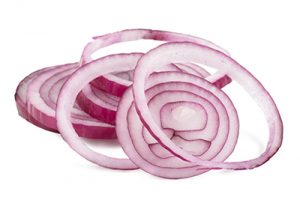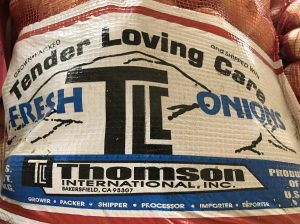This is over two months old, but should get it out there, because onions are an infrequent source of foodborne illness, despite being grown in the ground.
 The U.S. Centers for Disease Control reported that onions supplied by Thomson International, Inc., or any foods made with recalled onions, should not be eaten.
The U.S. Centers for Disease Control reported that onions supplied by Thomson International, Inc., or any foods made with recalled onions, should not be eaten.
As of August 31, 2020, a total of 1,012 people infected with the outbreak strain of Salmonella Newport have been reported from 47 states. A list of the states and the number of cases in each can be found on the Map of Reported Cases page.
Illnesses started on dates ranging from June 19, 2020, to August 11, 2020. Ill people range in age from less than 1 to 102 years, with a median age of 40. Fifty-seven percent of ill people are female. Of 581 ill people with information available, 136 hospitalizations have been reported. No deaths have been reported.
Illnesses might not yet be reported due to the time it takes between when a person becomes ill and when the illness is reported. This takes an average of 2 to 4 weeks. Please see the Timeline for Reporting Cases of Salmonella Infection for more details.
Whole genome sequencing analysis of 732 bacterial isolates from ill people did not predict any antibiotic resistance in 730 isolates; one isolate had predicted resistance to ampicillin, and one isolate had predicted resistance to tetracycline. Standard antibiotic susceptibility testing of seven clinical isolates by CDC’s National Antimicrobial Resistance Monitoring System (NARMS) laboratory showed no resistance. This resistance does not affect the choice of antibiotic used to treat most people.
Whole genome sequencing analysis shows that an outbreak of Salmonella Newport infections in Canada is related genetically to this outbreak in the United States. This means that people in both of these outbreaks are likely to share a common source of infection.
Recalled onion types include red, white, yellow, and sweet yellow varieties.
Foods made with recalled onions, such as cheese dips and spreads, salsas, and chicken salads, have also been recalled. These foods were sold at multiple grocery store chains. View the list of recalled onions and foods
Check your home for onions and other foods recalled by Thomson International, Inc. and several other companies, including Food Lion, Giant Eagle, Kroger, Publix, Ralph’s, Trader Joe’s, and Walmart.
 If you can’t tell where your onions are from, don’t eat them or any food made with them. Throw them away.
If you can’t tell where your onions are from, don’t eat them or any food made with them. Throw them away.
If you used recalled onions to make any other food, don’t eat the food. Throw it away, even if some of it was eaten and no one got sick.
Wash and sanitize any surfaces that may have come in contact with onions or their packaging, such as countertops, storage bins, refrigerator drawers, knives, and cutting boards.
When you order food from a restaurant or shop for food, check to make sure they are not serving or selling any recalled onions, foods prepared with recalled onions, or any recalled foods such as salads, sandwiches, tacos, salsas, and dips.
If they don’t know where their onions are from, don’t buy the product or order the food.
Check the list of recalled products.
If you don’t know where your onions are from, don’t serve or sell them.
View the list of recalled onions and foods
A total of 1,012 people infected with the outbreak strain of Salmonella Newport have been reported from 47 states.
136 hospitalizations have been reported. No deaths have been reported.
Epidemiologic and traceback information showed that red onions are a likely source of this outbreak. Due to the way onions are grown and harvested, other onion types, such as white, yellow, or sweet yellow, are also likely to be contaminated.
On August 19, 2020, Hello Fresh recalledexternal icon onions received by customers from May 8 through July 31, 2020.
See the full list ofrecalled onions and foods
This investigation is ongoing. CDC will provide more information as it becomes available.
